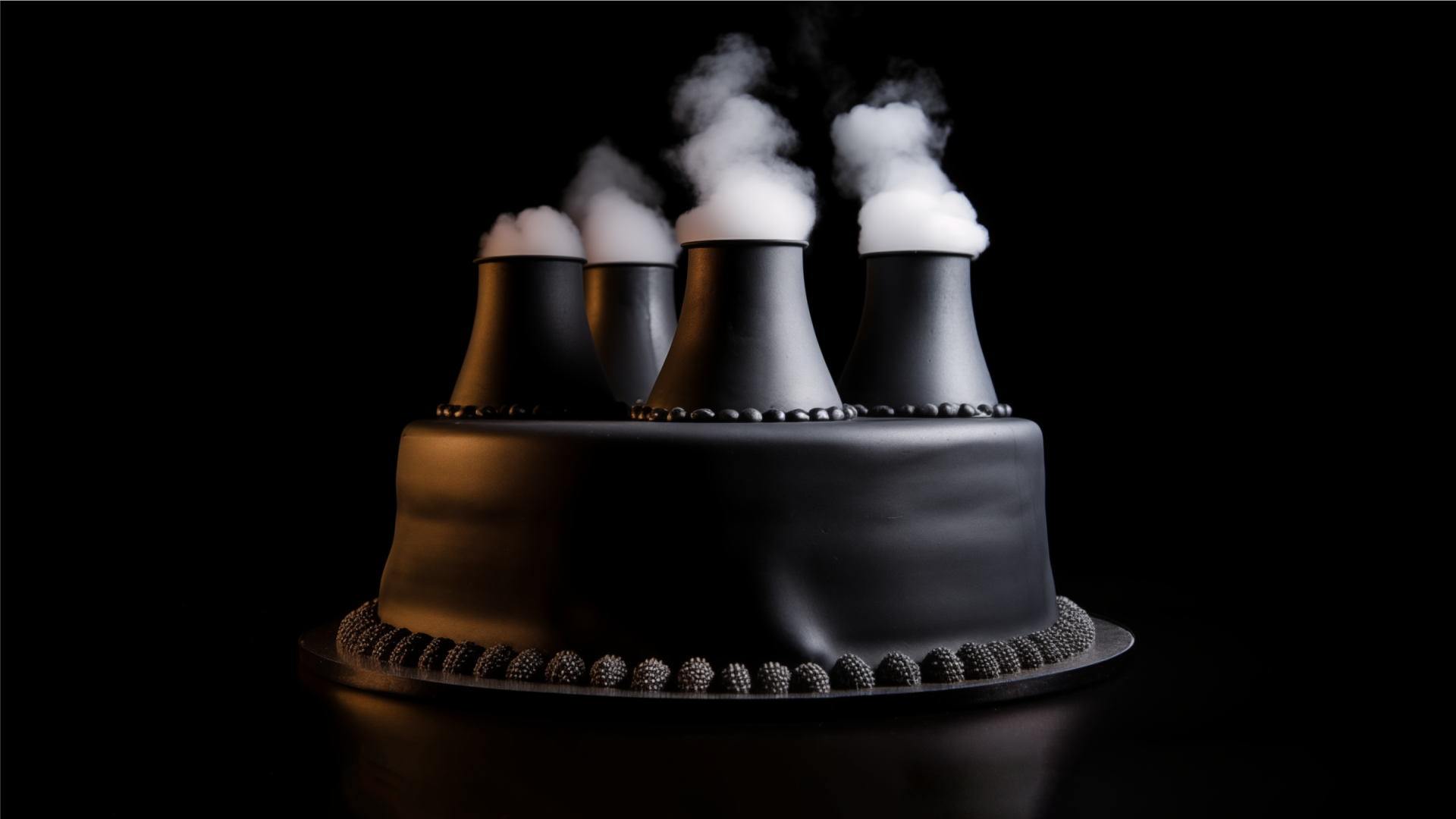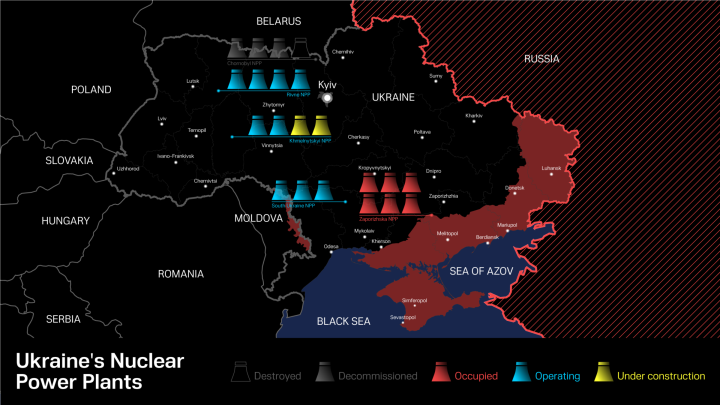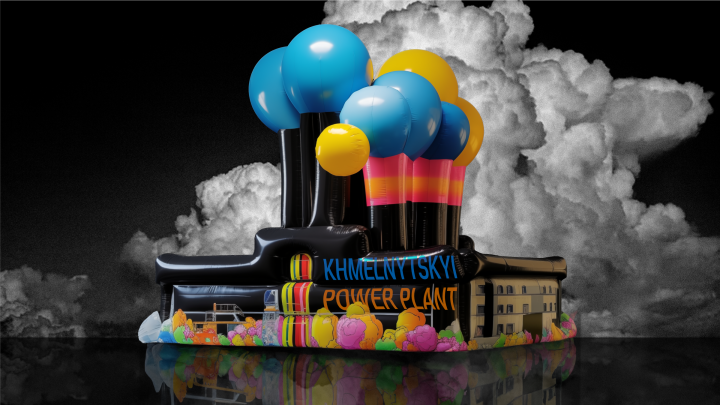- Category
- War in Ukraine
Ukraine Turns to More Nuclear Energy to Combat Russia's Energy Terrorism

Since March 2024, Russia has returned to its strategy of shelling Ukrainian energy infrastructure. In Ukraine, 90% of thermal generation, 75% of coal, and 40% of hydro generation have been destroyed, the shelling of energy facilities in each oblast continues, and the largest nuclear power plant in Europe is under occupation.
Stable energy is currently a significant challenge for Ukraine which is grappling with the results of a Russian missile campaign on its energy infrastructure. The country which before 2022 had covered its energy needs independently, now exists in a state of constant blackouts.
Emergency electricity imports from Europe alone, are insufficient to meet Ukraine’s energy needs. This prompted the Ukrainian government to consider building new reactors at the Khmelnytskyi Nuclear Power Plant (KNPP) as a solution, with a plan already in place.
In the summer of 2024, Ukraine’s Verkhovna Rada (Parliament) Committee on Energy and Housing and Communal Services approved a draft law that would expand the generating capacity of the Western Ukrainian KNPP by finishing the construction of power units no.3 and no.4 (both began construction in the 80’s). There are also plans to build two completely new units by 2030 at the same plant.
*In the completion of the no.3 and no.4 sections of the KNPP, Ukraine will be buying VVER-1000 type Rectors from Bulgaria that were originally manufactured for the Belene Nuclear Power Plant in Russia. The project was stopped in 2012 and the parts were being warehoused.
This all is in an attempt to effectively compensate for the destruction of Ukraine’s various other forms of electric generation:
Thermal (90%)
Coal (70 - 75% loss),
Hydroelectric (40%)
Natural gas (Significant but unspecified)
Nuclear power is responsible for over 50% of energy production in Ukraine, and that comes with its own set of significant risks and benefits.

Ripple effects
Pre-war, Ukraine was the seventh-largest producer of nuclear energy globally. Ukrainians were also highly self-sufficient as it produced 100% of its energy domestically – most of that came from carbon-neutral nuclear energy (55%), but there was a good amount of diversity in energy production. Ukraine was also a major exporter of energy to Europe.
Now in light of the systemic attacks on Ukraine’s energy infrastructure – they are being pushed towards reliance on a single energy source – which bolsters significant vulnerabilities.
Of Ukraine’s 15 nuclear reactors:
Nine are operational (4 Rivne, 3 Ukraine South, 2 Khmelnytskyi)
Six are under Russian occupation at the Zaporizhzhya NPP
7 more reactors are planned to be introduced in the future:
Four are under construction in Khmelnitsky
Three more have been planned (1 Rivne, 2 Ukraine south)

The strain on Ukraine’s nine operational reactors is serious, especially when considering that the war affects all of their output. Just take into account the increased demand, maintenance challenges, operational risks, regulatory hurdles, human resource issues, and logistical difficulties.
Ukraine has a multi-sided front and this is just focusing on the energy side of things. Firstly to compensate for the loss of generation capabilities, Ukraine has begun importing electricity from the European Union. With that the energy sector faces liquidity issues and substantial debts, making it challenging to fund repairs and maintenance of damaged infrastructure.
A report by the Wilson Center says that:
“If Russian air attacks do not further damage the power system, Ukraine will enter the winter of 2024–2025 in about the same condition as it entered last year’s winter, and likely with a deficit of capacities. But there is no reason to believe Russia will stay its hand and refrain from more attacks on Ukraine’s energy facilities, so expectations should be lowered. “
Extensive damage to power plants has disrupted the regular supply of electricity, and significant damage to the hydroelectric infrastructure has forced industries to rely more heavily on the remaining nuclear power, which is also under strain. Industries that consume a lot of energy, such as steel and chemical manufacturing, face higher operational costs due to the increased cost of energy imports and the need to operate under less stable power supply conditions.
The damage to infrastructure, increased operational costs, economic and financial strains, and workforce challenges are all contributing to a significant decline in industrial output and economic stability. Addressing these issues will require substantial investment, international support, and guarantees of plant safety.

Considerations
On the other side of the coin is a report by The Center for Environmental Initiatives “Ecodia” about the expansion of the No.3 and No.4 power units of the KNPP. Their analysis shows the risks of rushing complicated engineering projects.
“The current project for the completion of KNPP 3 and 4 is largely dependent on technologies and equipment of Russian origin, which contradicts the national interests of Ukraine and international sanctions. Reactors for it are planned to be purchased from Bulgaria from the unfinished Belene nuclear power plant. These are VVER-1000 series 466B reactors that do not fully meet modern safety standards developed by the Association of Western European Regulators for "deferred projects''. They do not take into account the safety principles that were developed after the 1980s.”
There are also the factors of environmental impact that the group considers in this expansion:
“Also in summer periods, when the temperature rises, KNPP is already forced to use additional water to cool reactors from the Goryn River, so without a detailed assessment of the water supply of the entire region, taking into account the simultaneous operation of four KNPP power units, there is no reason to argue that this project will not have a negative impact on both the ecosystem of Horyn and the region as a whole and guarantee the safe operation of reactors.”
On July 24, 2024, 5000 scientists who worked for Ukrenergoatom were evacuated from the Zaporizhzhia Nuclear Power Plant and returned to Ukrainian-controlled territory. Ukrainian energy minister Herman Galushchenko expects that will be used for the construction of the new KNPP units.
Ukraine is increasing its investment in nuclear energy to enhance its energy independence, following similar strategies adopted by some European countries. The Russian Federation has disrupted energy supplies in Europe, including through rocket strikes on infrastructure and cutting energy exports. Expanding nuclear energy capacity is seen as a viable strategy for Europeans to reduce their reliance on Russian energy sources and for Ukraine to stabilize its energy grid.

-c42261175cd1ec4a358bec039722d44f.jpg)
-46f6afa2f66d31ff3df8ea1a8f5524ec.jpg)
-6359eca46c72bde40a90abaaadd6eaa8.png)
-29a1a43aba23f9bb779a1ac8b98d2121.jpeg)


-206008aed5f329e86c52788e3e423f23.jpg)